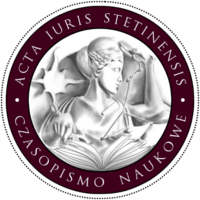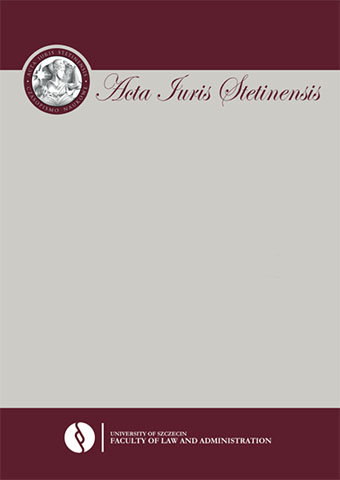







| Authors: |
Małgorzata
Ciepłuch
Uniwersytet Gdański |
| Keywords: | joint authorship. work authorship author computer-assisted works computer-generated works |
| Data publikacji całości: | 2016 |
| Page range: | 21 (37-57) |
| Downloads ?: | 714 |
| 1. | Ball B., Artificial music: The computers that create melodies, BBC News, 2014, http://www. bbc.com/future/story/20140808-music-like-never-heard-before (dostęp 19.07.2015). |
| 2. | Badavas Ch.P., MIDI Files: Copyright Protection for Computer-Generated Works, 35 William & Mary Law Review 1994, nr 1135. |
| 3. | Barta J., Dzieło muzyczne i jego twórca w świetle przepisów prawa autorskiego, Zeszyty Naukowe Uniwersytetu Jagiellońskiego, Prace z Wynalazczości i Ochrony Własności Intelektualnej nr 20, Kraków 1980. |
| 4. | Barta J., Markiewicz R., Prawo autorskie, Warszawa 2016. |
| 5. | Barr R., Computer-Produced Creations, w: WIPO Worldwide Symposium on the Intellectual Property Aspects of Artificial Intelligence, Stanford 1991. |
| 6. | Blackwell A., Collins N., The Programming Language as a Musical Instrument, Proceedings of Psychology of Programming Interest Group, Sussex 2005. |
| 7. | Białecki P., Tuchołka H., Fotografia na tle prawa autorskiego, „Monitor Prawniczy” nr 3/2002. |
| 8. | Blistein R., Triumph of the Cyborg Composer, Pacific Standard 2010, https://psmag.com/ triumph-of-the-cyborg-composer-620e5aead47e#.xq7td4jxl (dostęp 20.06.2016). |
| 9. | Błeszyński J., Fotografia jako przedmiot prawa autorskiego, Zeszyty Naukowe Uniwersytetu Jagiellońskiego, Prace z Wynalazczości i Ochrony Własności Intelektualnej 1980, nr 23. |
| 10. | Błeszyński J., Twórczość jako przesłanka ochrony w polskim prawie autorskim w świetle doktryny i orzecznictwa, w: Współczesne problemy prawa prywatnego. Księga pamiątkowa ku czci profesora Edwarda Gniewka, Warszawa 2010. |
| 11. | Cope D., Experiments in Music Intelligence, w: Proceedings of the International Computer Music Conference, San Francisco 1987. |
| 12. | Dornbusch P., Computer Sound Synthesis in 1951: The Music of CSIRAC, „Computer Music Journal” 2004, nr 28. |
| 13. | Flisak D., Komentarz do art. 1 ustawy o prawie autorskim i prawach pokrewnych, w: Prawo autorskie i prawa pokrewne. Komentarz., red. M. Bukowski, LEX 2015. |
| 14. | Flisak D., Pojęcie utworu w prawie autorskim – potrzeba głębokich zmian, „Przegląd Prawa Handlowego” 2006, nr 12. |
| 15. | Galanter P., What is Generative Art? Complexity Theory as a Context for Art Theory, referat wygłoszony podczas XV Generative Art International Conference, Generative Design Lab, Milan 2003. |
| 16. | Gillick J., A Clustering Algorithm for Recombinant Jazz Improvisations, 2009, http:// wesscholar.wesleyan.edu/cgi/viewcontent.cgi?article=1344&context=etd_hon_ theses (dostęp 20.09.2015). |
| 17. | Grzybowski S., Artysta wykonawca i jego dzieło a zagadnienia ochrony prawnej, „Studia Cywilistyczne” 1968, t. 12. |
| 18. | Gyertyanfy P., Copyright Protection of Coputer-Produced Creations, w: WIPO Worldwide Symposium on the Intellectual Property Aspects of Artificial Intelligence, Stanford 1991. |
| 19. | Hart R.J., Copyright and computer generated works, Aslib Proceedings 1988, Vol. 40, nr 6. |
| 20. | Kościelniak P., Sztuczna sztuka, „Rzeczpospolita” 24.05.2016, http://www.rp.pl/Nowetechnologie/ 305249899-Sztuczna-sztuka.html |
| 21. | McCutcheon J., The Vanishing Author in Computer-Generated Works: A Critical Analysis of Recent Australian Case Law, Melbourne University Law Review 2013, t. 36. |
| 22. | Machała W., Utwór. Przedmiot prawa autorskiego, Warszawa 2013. |
| 23. | Małek L., Cytat w świetle prawa autorskiego, Warszawa 2011. |
| 24. | Michalski B., Fotografia jako przedmiot prawa autorskiego, „Refleks” 1969, nr 10. |
| 25. | Miranda E.R., Readings in Music and Artificial Intelligence, New York 2013. |
| 26. | Perry M., Margoni T., From Music Tracks to Google Maps: Who Owns Computer-generated Works?, „Law Publications” 2014, nr 27. |
| 27. | Piesiewicz K., Utwór muzyczny i jego twórca, Warszawa 2009. |
| 28. | Prawo autorskie i prawa pokrewne. Komentarz, red. J. Barta, R. Markiewicz, LEX 2011. |
| 29. | Samuelson P., Allocating Ownership Rights in Computer-Generated Works, University of Pittsburgh Law Review 1985, t. 47, nr 1185. |
| 30. | Sarbiński R.M., Utwór fotograficzny i jego twórca w prawie autorskim, Zakamycze 2004. |
| 31. | Sherman B., Strowel A., Of Authors and Origins. Essays on Copyright, Oxford 1994. |
| 32. | Sorensen A., The Concert Programmer – OSCON 2014, https://www.youtube.com/ watch?v=yY1FSsUV-8c |
| 33. | Smith S., Iamus: Is this the 21st century’s answer to Mozart?, BBC News, http://www. bbc.com/news/technology-20889644 (dostęp 4.06.2016). |
| 34. | System Prawa Prywatnego t. 13. Prawo autorskie, red. J. Barta, R. Markiewicz, Warszawa 2013. |
| 35. | Sztuka generatywna, czyli sztuka maszyn, 2015, http://www.fpiec.pl/post/2015/07/02/ sztukageneratywna (dostęp 20.10.2015). |
| 36. | Traple E., Dzieło zależne jako przedmiot prawa autorskiego, Warszawa 1979. |
| 37. | Ustawa o prawie autorskim i prawach pokrewnych, red. J. Barta, R. Markiewicz, Warszawa 2003. |
| 38. | Ustawa o prawie autorskim i prawach pokrewnych. Komentarz, red. E. Ferenc-Szydełko, Warszawa 2011. |
| 39. | Wiggins G.A., Computer Models of Musical Creativity: A Review of Computer Models of Musical Creativity by David Cope, Literary and Linguistic Computing 2008, Vol. 23, No. 1. |
| 40. | Konwencja berneńska o ochronie dzieł literackich i artystycznych z dnia 9 września 1886 r., przejrzana w Berlinie dnia 13 listopada 1908 r. i w Rzymie dnia 2 czerwca 1928 r. (ratyfikowana zgodnie z ustawą z dnia 5 marca 1934 r.) (Dz.U. 1935 nr 84, poz. 515) . |
| 41. | Ustawa z dnia 4 lutego 1994 r. o prawie autorskim i prawach pokrewnych (Dz.U. 1994 nr 24, poz. 83). |
| 42. | Copyright Act of 1976, 17 U.S.C. §§ 101-810, Pub. L. 94-553 (Oct. 19, 1976), http://www.copyright.gov/title17/circ92.pdf (dostęp 20.06.2016). |
| 43. | Copyright, Design and Patents Act, U.K. 1988, http://www.legislation.gov.uk/ukpga/1988/48/contents (dostęp 10.06.2016). |
| 44. | South Africa Copyright Act, No. 98 of 1978, http://www.nlsa.ac.za/downloads/Copyright%20Act.pdf (dostęp 10.06.2016). |
| 45. | Copyright Act 1994/143, Nowej Zelandii,http://www.legislation.govt.nz/act/public/1994/0143/latest/DLM345634.html (dostęp 10.06.2016). |
| 46. | Wyrok Sądu Apelacyjnego w Krakowie z dnia 30 grudnia 2014 r., sygn. akt. I Aca 1433/14, LEX nr 1651904; Wyrok Sądu Apelacyjnego w Łodzi z dnia 17 grudnia 2002 r., sygn. akt I ACa 254/02, LEX nr 535064 |
| 47. | Apple Computer, Inc. v. Franklin Computer Corp., 714 F.2d 1240 (3d Cir. 1983), http://law.justia.com/cases/federal/district-courts/FSupp/545/812/1432138/ (dostęp 20.06.2016). |
| 48. | Carson v. Here’s Johny Portable Toilets, 698 F.2d 831 (6th Circuit 1983), http://law.justia.com/cases/federal/district-courts/FSupp/498/71/1652758/ (dostęp 20.06.2016). |
| 49. | Waits v. Frito-Lay , 978 F.2d 1093 (9th Circuit 1992), http://law2.umkc.edu/faculty/projects/ftrials/communications/waits.html(dostęp 20.06.2016). |
| 50. | Jarvis v. A&M Records 927 F. Supp. 282 (D.N.J. 1993), http://mcir.usc.edu/cases/1990-1999/Pages/jarvisamrecords.html (dostęp 20.06.2016). |
| 51. | Alfred Bell & Co. Ltd. v. Catalda Fine Arts, Inc.191 F.2d 99 (2d Cir. 1951), http://law.justia.com/cases/federal/appellate-courts/F2/191/99/91570/ (dostęp 20.06.2016). |
| 52. | National Comission on New Technological Uses of Copyright Works, 1978, Final Report of the National Comission on New Technological Uses of Copyrighted Works, |
| 53. | Library of Congress, Waszyngton., http://people.ischool.berkeley.edu/~bcarver/mediawiki/images/8/89/CONTU.pdf (dostęp 12.02.2016). |
| 54. | Komisja Kodyfikacyjna Prawa Autorskiego, Protokoły obrad sekcji prawa cywilnego komisji kodyfikacyjnej Rzeczypospolitej Polskiej, Prawo autorskie, Kraków 1921. |
| 55. | http://www.koenigproject.nl/indexe.htm (dostęp 20.07.2015). |
| 56. | http://www.apple.com/pl/pr/library/2013/07/16Apple-Unveils-Logic-Pro-X.html (dostęp 20.06.2016). |
| 57. | http://magenta.tensorflow.org/welcome-to-magenta (dostęp 20.06.2016). |